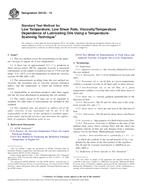Potřebujeme váš souhlas k využití jednotlivých dat, aby se vám mimo jiné mohly ukazovat informace týkající se vašich zájmů. Souhlas udělíte kliknutím na tlačítko „OK“.
ASTM D5133-13
Standard Test Method for Low Temperature, Low Shear Rate, Viscosity/Temperature Dependence of Lubricating Oils Using a Temperature-Scanning Technique
Automaticky přeložený název:
Standardní zkušební metoda pro nízké teploty, nízká Shear Rate, viskozita / Teplotní závislost mazacích olejů za použití teploty skenování Technika
NORMA vydána dne 1.9.2013
Informace o normě:
Označení normy: ASTM D5133-13
Poznámka: NEPLATNÁ
Datum vydání normy: 1.9.2013
Kód zboží: NS-29964
Počet stran: 13
Přibližná hmotnost: 39 g (0.09 liber)
Země: Americká technická norma
Kategorie: Technické normy ASTM
Anotace textu normy ASTM D5133-13 :
Keywords:
borderline pumping temperature, critical pumpability temperature, critical pumpability viscosity, engine oil, gelation, Gelation Index, Gelation Index temperature, low-temperature engine oil pumpability, low-temperature rheology, Scanning Brookfield technique, temperature-scanning technique, viscosity, ICS Number Code 75.100 (Lubricants, industrial oils and related products)
Doplňující informace
| Significance and Use | ||||||
|
5.1 Significance of Low-Temperature, Low Shear Rate, Engine Oil Rheology—The low-temperature, low-shear viscometric behavior of an engine oil determines whether the oil will flow to the sump inlet screen, then to the oil pump, then to the sites in the engine requiring lubrication in sufficient quantity to prevent engine damage immediately or ultimately after cold temperature starting. 5.1.1 Two forms of flow problems have been identified,5.2 Significance of the Test Method—The temperature-scanning technique employed by this test method was designed to determine the susceptibility of the engine oil to flow-limited and air-binding response to slow cooling conditions by providing continuous information on the rheological condition of the oil over the temperature range of use.4 ,5.3 Gelation Index and Gelation Index Temperature—This test method has been further developed to yield parameters called the Gelation Index and Gelation Index temperature. The first parameter is a measure of the maximum rate of torque increase caused by the rheological response of the oil as the oil is cooled slowly. The second parameter is the temperature at which the Gelation Index occurs. |
||||||
| 1. Scope | ||||||
|
1.1 This test method covers the measurement of the apparent viscosity of engine oil at low temperatures. 1.2 A shear rate of approximately 0.2 s-1 is produced at shear stresses below 100 Pa. Apparent viscosity is measured continuously as the sample is cooled at a rate of 1°C/h over the range −5 to −40°C, or to the temperature at which the viscosity exceeds 40 000 mPa·s (cP). 1.3 The measurements resulting from this test method are viscosity, the maximum rate of viscosity increase (Gelation Index), and the temperature at which the Gelation Index occurs. 1.4 Applicability to petroleum products other than engine oils has not been determined in preparing this test method. 1.5 The values stated in SI units are to be regarded as standard. No other units of measurement are included in this standard. 1.6 This standard does not purport to address all of the safety concerns, if any, associated with its use. It is the responsibility of the user of this standard to establish appropriate safety and health practices and determine the applicability of regulatory limitations prior to use. |
||||||
| 2. Referenced Documents | ||||||
|
Odebírejte informace o nově vydaných normách ZDARMA:
Chcete pravidelně odebírat informace o nově vycházejících normách z celého světa a to zcela zdarma?
Přihlašte se k odběru. Vše je velice jednoduché a absolutně ZDARMA.
Na výběr máte vydavatele z celého světa.




 Cookies
Cookies
